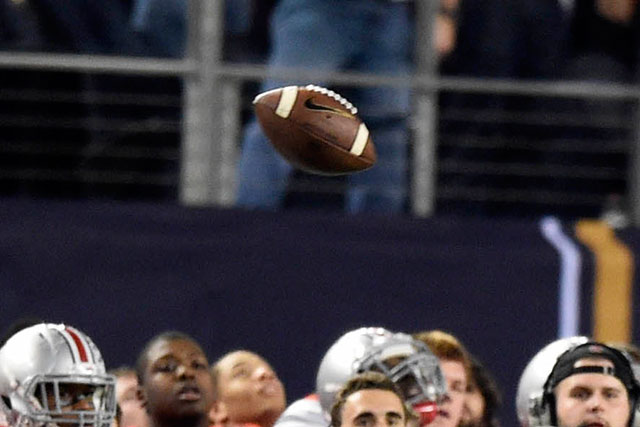Tom Dienhart, BTN.com Senior Writer, January 23, 2015
The football world has been buzzing with the ?deflategate? scandal that is hitting the New England Patriots this week.
There are rules pertaining to properly inflating a ball for NCAA games. You can read them here.
So, are balls deflated in college games?
?I do know – there are times when you?d like to get some air out of a ball, but I don?t think deflating balls is something rampant or goes on,? a Big Ten East offensive coordinator told me. ?To say someone would go through great lengths ? our (quarterbacks) just know what it feels like in their hands.?
What about from a defensive perspective?
?Not really that I know of,? said a Big Ten East defensive coordinator when I asked if he thought ball deflation was an issue. ?But you would think with as volatile as the sport is, everyone wants to do what they can to get an advantage. You may not try to break rules, but you will push it to the limit.?
This story by Keith Sargeant on NJ.com gives a good summation of how the game-ball process works. Teams give balls to officials before games to be inspected. As Sargeant writes, "The specifications are the same, with both the NFL and NCAA game ball required to be inflated to the pressure of 12-1/2 to 13-1/2 pounds per square inch and weigh 14 to 15 ounces."
The number of balls handed over for scrutiny can vary, depending on weather conditions that day.
?We hand in 10, sometimes more,? the Big Ten East offensive coordinator told me.
After the balls are inspected and approved, officials mark the balls. They are then kept in bag until game time. During the course of a game, the only person who retrieves a new game ball from the bag is the team?s ball boy. He hands it to the referees. If a team is charged with altering a ball, it is a 15-yard penalty.
?My equipment guy and my quarterback manager present our balls to the officials,? said the offensive coordinator. ?We try to break-in game balls during the week. We don?t use the same game balls from week to week.
?On Sunday when we practice, we may break out 10 new balls and practice with them that week. Sometimes they sand them down, do things to help with their grip. Then the quarterback will come in on Thursday and pick the balls he wants to play with that Saturday-10 or 15. The quarterback manager and equipment guy puts the balls in the game ball bag and gives them to the referees on Saturday.?
A Big Ten West offensive coordinator told me that a deflated ball is easier to grip and catch, especially in cold or wet weather.
?A good football has some give to it,? he said. ?There is a slight advantage. Like wearing gloves, which helps you control the ball. Leather gets hard in cold and wet, a deflated ball gives you more control.?
Forget quarterbacks. All three coordinators I spoke with think kickers may be the players to scrutinize the most when it comes to ball gimmickry.
?There have been times we have seen a kicker come out to kick a field goal and you see an old, brown, beat-up ball being used,? said the Big Ten East OC. ?How did that get in the game? That stuff can happen on sidelines. I know there are times kickers had old, bloated kicking balls ? ball boys are taught to grab one of those old bloated balls on long field goals. That?s not supposed to happen. That?s as bad as a deflated ball.?
Said the DC: ?Kickers like to use old, scuffed up balls that take off like a rocket when you punt it or kick it.?
But deflated footballs? In Big Ten games?
?I never have seen one of our ball boys on the sideline letting air out of balls,? said the Big Ten East OC. ?Once (the balls) are in the game, they are in the game. It would be interesting to know how the balls got deflated (by New England). A ball boy would have to have a needle in his hand and let air out of it on the sideline during the game.?
***
| About Tom Dienhart | BTN.com senior writer Tom Dienhart is a veteran sports journalist who covers Big Ten football and men's basketball for BTN.com and BTN TV. Find him on Twitter and Facebook, read all of his work at btn.com/tomdienhart, and subscribe to his posts via RSS. Also, send questions to his weekly mailbag using the form below and read all of his previous answers in his reader mailbag section. |
And if you want to leave a comment on this post, use the box below. All comments need to be approved by a moderator.







